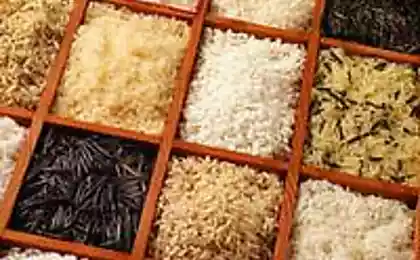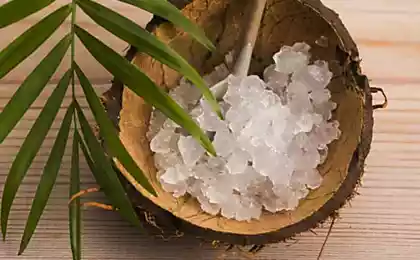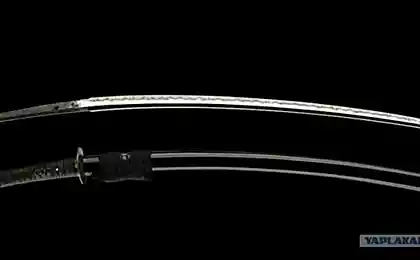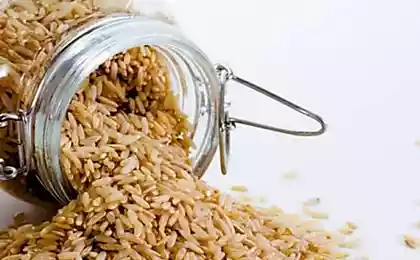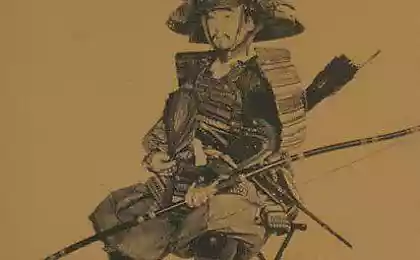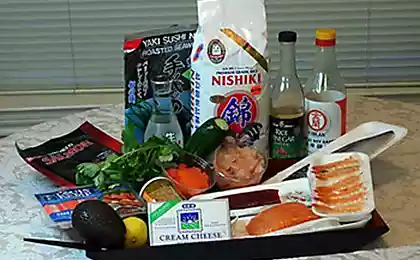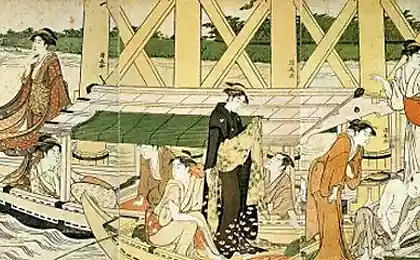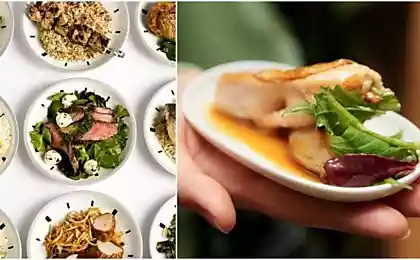930
The diet of the samurai— Zen, katana, a Cup of rice
The samurai is harsh and strong, and sometimes fierce warriors of the Japanese middle Ages – almost never used meat for food.
Legendary Japanese warriors of the middle ages – the samurai – were vegetarians. The samurai is harsh and strong, and sometimes fierce warriors of the Japanese middle Ages – almost never used meat for food.
They were all landowners (although often small), then there is a privileged class of Japan, along with traders. Scorning the peaceful life of peasants and artisans, the samurai never parted with his long sword (katana) and spent all his life in civil wars and inter-clan intrigues. Of course, the life of the samurai demanded great physical strength and often brute force. Excluding the most senior, all the samurai trained daily with my sword, doing physical exercise. In the military training of every samurai's mandatory training was practices energy work (Ju-jitsu, etc.). Overall, the samurai were a very healthy, physically developed and hardened men, who maintained the combat capability in all conditions.
To some it may seem that these people, possessing iron health and a lot of militancy, consumed a lot of meat and game, or ate fish every day. However, paradoxically, a privileged class of feudal Japan were treated with a diet consisting mostly of rice and vegetables, and fish, and the more meat they ate very meager amount and not every day. The fact is that the warriors-the samurai, famous throughout the world for their fighting qualities and strength of spirit, managed vegetarian diet, and it is quite strict and limited amount of food. The paradox or regularity?
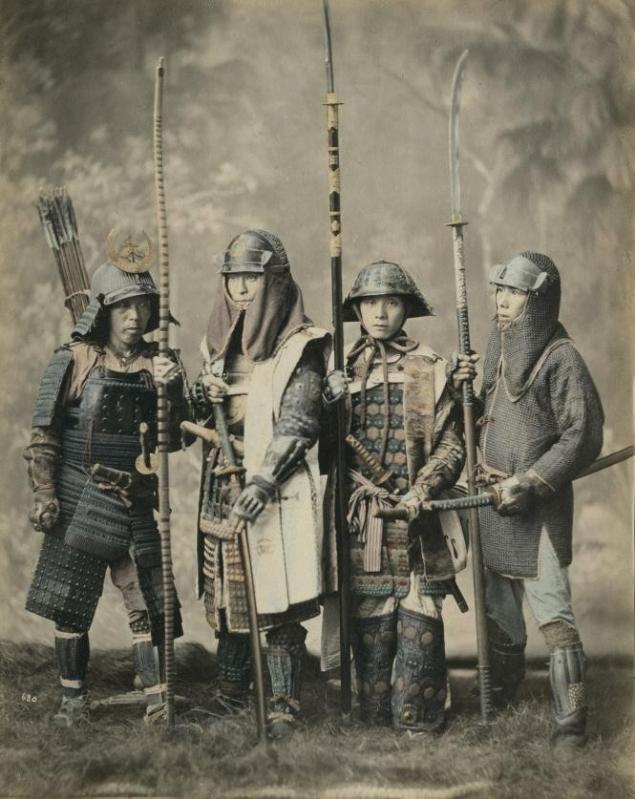
First, we must remember that for the true samurai, there was no such thing as "right" or "healthy" food. If someone started talking about health issues, the samurai could only shrug. Raised on a Zen indifference to the inevitable (and possibly fast!) death, and often imbued with a warlike concept of "love to death" of Bushi-do (the medieval code of conduct and philosophy of the samurai), the samurai's not that I despise life, but did not seek to renew it. The ideal for them was a symbol of the Sakura (Japanese cherry), which blossoms very beautifull, but quickly flies. They understood that perhaps, very soon, maybe even today or tomorrow – they will have to discard his "mortal body," and, God forbid, if in a fair fight for the glory of the overlord! The samurai respected stores and even there is evidence that each of the samurai in the Hiking pack was a first aid kit, which included a pretty serious set of drugs, starting with dressing materials to the hangover cure. However, the concept of maintaining health for longevity was alien to them, the samurai wasn't too concerned – no more than it was rational to preserve combat readiness. Motivation in the diet was more gastronomy: eat.
It may seem to us that in Japan, "the country land" — there was never a shortage of fresh fish and seafood, but it's not. It is curious that what little (according to British scientists, who formed the academic "Kubricky Japanese history" in six volumes, vol. 2) "insignificant" number of fish which they consumed was dried fish. In medieval Japan, transportation was slow and uncomfortable means of transportation, and refrigerators, of course, not yet invented – so fresh fish was only available to the richest aristocrats – and, of course, residents of the fishing villages on the coast. The samurai had access to fresh fish, but the amount still fell on the table of the most prosperous parts of them, were very meager, and it is unlikely that had the rich taste.
The main course, which the samurai had every day for every meal (and they eat 2-3 times a day), and they really loved was the rice. No wonder the Japanese word "gohan" means both "rice" and "food." Of course, rice was the basis of the strength of the samurai, because he was the main source of calories. Obviously, the samurai were no psychological problems to eat rice for Breakfast, lunch, and dinner. In General, we can say that in those days, simple white rice was as prestigious and desirable food, as in our days, for example, in China red meat.
Ate mainly white (peeled) rice, which was considered the best. It was prepared in different ways: boiled, prepared on pair, made of glutinous rice cakes (stuffed vegetables), sometimes made of rice cakes; for the road took dried rice cakes with filling or without filling can be, for example, a piece of pickled vegetable or dried and soaked plums, dried apricots). Sometimes the rice can mix with other cereals (e.g. red beans), sometimes with nuts (mainly hazelnuts), or make a "gruel" of badly boiled rice with plenty of water: by the way, this dish was considered good for digestion and overall nutrient, supplied at the ailments. Festive table, and the samurai were very fond of feasts, they were an important part of their life estate, the servant was cooking rice with thin slices of sweet potato. Dish optional'm perfuming special sweet sauce amazura", which received vivaria fruity wine.
Eating rice was considered a privilege: the majority of peasants and artisans, especially urban, could not afford such a diet (ate millet and other cereals not so nutritious, and it had a negative impact on health; this is reflected in the classic movie A. Kurosawa's "Seven samurai"). Portion of the samurai was always greater portion of his household (including his wife, children and the elderly), but according to historians in terms of calorie even the meal the head of the family was about 1.600-2.000 calories, not more (in different periods of caloric content was slightly varied). In fairness it should be emphasized that the rice, which was consumed by the samurai, these days would be considered, obviously, the elite: it was organic, grown in a clean environment, collected manually, and of course free from any chemicals and tricks of genetic engineering – and, hence, quite nutritious.
However, still not worth it to spare the samurai, believing that for lunch they ate a "naked pic". The rice on the table have traditionally relied several types of garnish, including in excess thermally processed vegetables. The lack of nutrients, which of course could not cover white rice, filled vegetables, sprouts, greens. The samurai ate rice, eggplant, onion, green onions, white radish (daikon) – sometimes pickled, bamboo shoots, various legumes, greens, etc. Used also a large number of various useful mushrooms (Shiitake mushrooms, Maitake, Cordyceps, etc. – are extremely useful natural immunomodulators) that are traditionally served in Japan in our days. Vegetables are always boiled or prepared on pair, and was in the course of the pickled vegetable pieces: they could be stored in the cellar. In addition, the samurai had used a large number of marine algae, ospanovich the lack of iodine. Eat naturally and soy products (tofu, miso soup, etc.) – one of the pillars of Japanese cuisine.
Consumption of milk and dairy products was basically a lot of the most wealthy samurai, though in the Heian period (the heyday of samurai culture) they were distributed and available more widely.
From spices samurai were very fond of salt, and a mixture of salt and onion. Also used garlic, ginger, vinegar, fish sauce, miso paste.
Sweet been "amazura", and a special honey and marmalade, which is prepared from boiled glutinous rice: no sugar! On holidays, preparing special "Chinese" cakes "Karagai". The pasties from one or more types of flour, put inside the filling of bean paste, rice or "marmalade", pieces of vegetables or duck eggs. Fried in sesame or peanut oil (walnut). By the way, it was a treat (and its variations) is prepared in Japan to this day.
And here's another samurai delicacy is not honored: for the holidays they bring to the table finely crushed ice, which in summer was kept in a special basement: eat (beautifully presented!) the ice was considered refined and aristocratic.
Food "not every day" were also fruits: persimmons, pears, tangerines, plums, peaches, apples, Japanese medlars, pomegranates. Fruits and nuts (hazelnuts, walnuts, pine) served as the fruit, in small quantities, and mostly on especially solemn occasions, or in case of illness – as a medicine.
Treatment was considered and green tea, which, by the way, never used in excess. The art of tea (tea ceremony) part of the range is traditionally mastered by the samurai, along with prosody (the skill of the folding of short poems: five - and treastise) and calligraphy. There is evidence that tea was grown in the capital (Edo) and beyond.
In one of the most authoritative codes of Bushi to samurai morality and daily behavior — "Budo Otani sesin Xu" (author Daidoji, Uzan, 1639-1730) – recorded: "Near his home samurai can build a modest tea pavilion which should use the new paintings-hanging scroll, modern, modest cups, and nalakirovannye ceramic teapot". Tea ceremony of the samurai differ from the standard in China: tea ground into a powder, carefully prepared water, and brewed tea in large cups (about 0.3 — 0.5 liters), drank one Cup for tea. It was believed that drinking 2-3 cups of green tea a day, drink tea, useful in itself – good for the body, and to an even greater extent focus on the process of cooking, serving and brewing – "the tea act" – good for the soul of the samurai, the education detachment, and increase concentration. Such principles were quite in keeping with the philosophy of the Buddhist sect Zen, extremely popular (along and sometimes "mixed" with Japanese Shinto) among the samurai. The principles of tea ceremony: simplicity, purity, reverence, you might say, was the main idea of the power of the samurai in General.
It should be noted that if the tea was useful and noble, aristocratic drink, a drink of the samurai was sake – not strong, slightly intoxicating rice wine. According to historians, the sake samurai was pretty weak, but nevertheless had a powerful impact, because the overall diet was fairly austere and virtually eliminating the meat. Unaccustomed to rough food energy vibrations, the samurai from the sake, quickly got drunk and it was welcome. Sake was unleashed language, communication became more informal. Drinking sake in the company of their colleagues was in the extremely formal culture of the samurai kind of an outlet and a "steam valve" – a way to relax, forget about the ranks, to talk "for life" and not about business. However, drinking sake is never excessive, basically the samurai were drinking just pure water to the head was fresh, and the hand is solid; above all, the samurai valued the military strength and ability at any moment to carry out your samurai duty: to kill or to die fighting for the honor of the Lord or his own.
In General, except for holiday meals, the food of the samurai was prepared very simple and not abundant, one might even say that eating very little in comparison with the present day: one to two cups of rice. "We need to be moderate in eating and to avoid promiscuity" – is strictly punished the samurai all the same code "Budo Otani sesin Xue" (which means "the rudiments of martial arts). But the aesthetic aspect is never limp: the food was made to serve beautiful, even if the samurai was poor. Samurai (except, of course, the little fir from beautiful red lacquered plates and drank from silver cups. The simplicity and legkousvoyaemogo freshly prepared food complemented respect for rice and the process of eating, peculiar to the Japanese culture so far. (A small amount of the food consumed, obviously, was for the benefit of the body: remember, because one of the principles of healthy eating in Indian Ayurveda – fill only 3\4 of the stomach.)
Thus, we understand, were the legendary samurai health: although food and contained only the bare minimum of calories (the main source of which was white rice), but were rich in nutrients due to the use of a large number of vegetables and herbs, different mushrooms and soy products. It is worth noting that in our days in Japan, in connection with the welfare of the nation and the penetration of Western and Chinese culture, of course, there is a widespread consumption of meat products and fish, seafood, and a modern "junk" store food, but the tradition of eating healthy foods has been preserved from the time of the samurai to this day, to a much greater extent than in the West. Japanese cuisine and is one of the most healthy and nutritious, as evidenced by the large number of centenarians and the General very high life expectancy in Japan (78.8 years for men, 85.62 years for women). May I wish you, dear readers, the strong "samurai" Japanese true health and longevity!
source
Source: /users/87
Legendary Japanese warriors of the middle ages – the samurai – were vegetarians. The samurai is harsh and strong, and sometimes fierce warriors of the Japanese middle Ages – almost never used meat for food.
They were all landowners (although often small), then there is a privileged class of Japan, along with traders. Scorning the peaceful life of peasants and artisans, the samurai never parted with his long sword (katana) and spent all his life in civil wars and inter-clan intrigues. Of course, the life of the samurai demanded great physical strength and often brute force. Excluding the most senior, all the samurai trained daily with my sword, doing physical exercise. In the military training of every samurai's mandatory training was practices energy work (Ju-jitsu, etc.). Overall, the samurai were a very healthy, physically developed and hardened men, who maintained the combat capability in all conditions.
To some it may seem that these people, possessing iron health and a lot of militancy, consumed a lot of meat and game, or ate fish every day. However, paradoxically, a privileged class of feudal Japan were treated with a diet consisting mostly of rice and vegetables, and fish, and the more meat they ate very meager amount and not every day. The fact is that the warriors-the samurai, famous throughout the world for their fighting qualities and strength of spirit, managed vegetarian diet, and it is quite strict and limited amount of food. The paradox or regularity?

First, we must remember that for the true samurai, there was no such thing as "right" or "healthy" food. If someone started talking about health issues, the samurai could only shrug. Raised on a Zen indifference to the inevitable (and possibly fast!) death, and often imbued with a warlike concept of "love to death" of Bushi-do (the medieval code of conduct and philosophy of the samurai), the samurai's not that I despise life, but did not seek to renew it. The ideal for them was a symbol of the Sakura (Japanese cherry), which blossoms very beautifull, but quickly flies. They understood that perhaps, very soon, maybe even today or tomorrow – they will have to discard his "mortal body," and, God forbid, if in a fair fight for the glory of the overlord! The samurai respected stores and even there is evidence that each of the samurai in the Hiking pack was a first aid kit, which included a pretty serious set of drugs, starting with dressing materials to the hangover cure. However, the concept of maintaining health for longevity was alien to them, the samurai wasn't too concerned – no more than it was rational to preserve combat readiness. Motivation in the diet was more gastronomy: eat.
It may seem to us that in Japan, "the country land" — there was never a shortage of fresh fish and seafood, but it's not. It is curious that what little (according to British scientists, who formed the academic "Kubricky Japanese history" in six volumes, vol. 2) "insignificant" number of fish which they consumed was dried fish. In medieval Japan, transportation was slow and uncomfortable means of transportation, and refrigerators, of course, not yet invented – so fresh fish was only available to the richest aristocrats – and, of course, residents of the fishing villages on the coast. The samurai had access to fresh fish, but the amount still fell on the table of the most prosperous parts of them, were very meager, and it is unlikely that had the rich taste.
The main course, which the samurai had every day for every meal (and they eat 2-3 times a day), and they really loved was the rice. No wonder the Japanese word "gohan" means both "rice" and "food." Of course, rice was the basis of the strength of the samurai, because he was the main source of calories. Obviously, the samurai were no psychological problems to eat rice for Breakfast, lunch, and dinner. In General, we can say that in those days, simple white rice was as prestigious and desirable food, as in our days, for example, in China red meat.
Ate mainly white (peeled) rice, which was considered the best. It was prepared in different ways: boiled, prepared on pair, made of glutinous rice cakes (stuffed vegetables), sometimes made of rice cakes; for the road took dried rice cakes with filling or without filling can be, for example, a piece of pickled vegetable or dried and soaked plums, dried apricots). Sometimes the rice can mix with other cereals (e.g. red beans), sometimes with nuts (mainly hazelnuts), or make a "gruel" of badly boiled rice with plenty of water: by the way, this dish was considered good for digestion and overall nutrient, supplied at the ailments. Festive table, and the samurai were very fond of feasts, they were an important part of their life estate, the servant was cooking rice with thin slices of sweet potato. Dish optional'm perfuming special sweet sauce amazura", which received vivaria fruity wine.
Eating rice was considered a privilege: the majority of peasants and artisans, especially urban, could not afford such a diet (ate millet and other cereals not so nutritious, and it had a negative impact on health; this is reflected in the classic movie A. Kurosawa's "Seven samurai"). Portion of the samurai was always greater portion of his household (including his wife, children and the elderly), but according to historians in terms of calorie even the meal the head of the family was about 1.600-2.000 calories, not more (in different periods of caloric content was slightly varied). In fairness it should be emphasized that the rice, which was consumed by the samurai, these days would be considered, obviously, the elite: it was organic, grown in a clean environment, collected manually, and of course free from any chemicals and tricks of genetic engineering – and, hence, quite nutritious.
However, still not worth it to spare the samurai, believing that for lunch they ate a "naked pic". The rice on the table have traditionally relied several types of garnish, including in excess thermally processed vegetables. The lack of nutrients, which of course could not cover white rice, filled vegetables, sprouts, greens. The samurai ate rice, eggplant, onion, green onions, white radish (daikon) – sometimes pickled, bamboo shoots, various legumes, greens, etc. Used also a large number of various useful mushrooms (Shiitake mushrooms, Maitake, Cordyceps, etc. – are extremely useful natural immunomodulators) that are traditionally served in Japan in our days. Vegetables are always boiled or prepared on pair, and was in the course of the pickled vegetable pieces: they could be stored in the cellar. In addition, the samurai had used a large number of marine algae, ospanovich the lack of iodine. Eat naturally and soy products (tofu, miso soup, etc.) – one of the pillars of Japanese cuisine.
Consumption of milk and dairy products was basically a lot of the most wealthy samurai, though in the Heian period (the heyday of samurai culture) they were distributed and available more widely.
From spices samurai were very fond of salt, and a mixture of salt and onion. Also used garlic, ginger, vinegar, fish sauce, miso paste.
Sweet been "amazura", and a special honey and marmalade, which is prepared from boiled glutinous rice: no sugar! On holidays, preparing special "Chinese" cakes "Karagai". The pasties from one or more types of flour, put inside the filling of bean paste, rice or "marmalade", pieces of vegetables or duck eggs. Fried in sesame or peanut oil (walnut). By the way, it was a treat (and its variations) is prepared in Japan to this day.
And here's another samurai delicacy is not honored: for the holidays they bring to the table finely crushed ice, which in summer was kept in a special basement: eat (beautifully presented!) the ice was considered refined and aristocratic.
Food "not every day" were also fruits: persimmons, pears, tangerines, plums, peaches, apples, Japanese medlars, pomegranates. Fruits and nuts (hazelnuts, walnuts, pine) served as the fruit, in small quantities, and mostly on especially solemn occasions, or in case of illness – as a medicine.
Treatment was considered and green tea, which, by the way, never used in excess. The art of tea (tea ceremony) part of the range is traditionally mastered by the samurai, along with prosody (the skill of the folding of short poems: five - and treastise) and calligraphy. There is evidence that tea was grown in the capital (Edo) and beyond.
In one of the most authoritative codes of Bushi to samurai morality and daily behavior — "Budo Otani sesin Xu" (author Daidoji, Uzan, 1639-1730) – recorded: "Near his home samurai can build a modest tea pavilion which should use the new paintings-hanging scroll, modern, modest cups, and nalakirovannye ceramic teapot". Tea ceremony of the samurai differ from the standard in China: tea ground into a powder, carefully prepared water, and brewed tea in large cups (about 0.3 — 0.5 liters), drank one Cup for tea. It was believed that drinking 2-3 cups of green tea a day, drink tea, useful in itself – good for the body, and to an even greater extent focus on the process of cooking, serving and brewing – "the tea act" – good for the soul of the samurai, the education detachment, and increase concentration. Such principles were quite in keeping with the philosophy of the Buddhist sect Zen, extremely popular (along and sometimes "mixed" with Japanese Shinto) among the samurai. The principles of tea ceremony: simplicity, purity, reverence, you might say, was the main idea of the power of the samurai in General.
It should be noted that if the tea was useful and noble, aristocratic drink, a drink of the samurai was sake – not strong, slightly intoxicating rice wine. According to historians, the sake samurai was pretty weak, but nevertheless had a powerful impact, because the overall diet was fairly austere and virtually eliminating the meat. Unaccustomed to rough food energy vibrations, the samurai from the sake, quickly got drunk and it was welcome. Sake was unleashed language, communication became more informal. Drinking sake in the company of their colleagues was in the extremely formal culture of the samurai kind of an outlet and a "steam valve" – a way to relax, forget about the ranks, to talk "for life" and not about business. However, drinking sake is never excessive, basically the samurai were drinking just pure water to the head was fresh, and the hand is solid; above all, the samurai valued the military strength and ability at any moment to carry out your samurai duty: to kill or to die fighting for the honor of the Lord or his own.
In General, except for holiday meals, the food of the samurai was prepared very simple and not abundant, one might even say that eating very little in comparison with the present day: one to two cups of rice. "We need to be moderate in eating and to avoid promiscuity" – is strictly punished the samurai all the same code "Budo Otani sesin Xue" (which means "the rudiments of martial arts). But the aesthetic aspect is never limp: the food was made to serve beautiful, even if the samurai was poor. Samurai (except, of course, the little fir from beautiful red lacquered plates and drank from silver cups. The simplicity and legkousvoyaemogo freshly prepared food complemented respect for rice and the process of eating, peculiar to the Japanese culture so far. (A small amount of the food consumed, obviously, was for the benefit of the body: remember, because one of the principles of healthy eating in Indian Ayurveda – fill only 3\4 of the stomach.)
Thus, we understand, were the legendary samurai health: although food and contained only the bare minimum of calories (the main source of which was white rice), but were rich in nutrients due to the use of a large number of vegetables and herbs, different mushrooms and soy products. It is worth noting that in our days in Japan, in connection with the welfare of the nation and the penetration of Western and Chinese culture, of course, there is a widespread consumption of meat products and fish, seafood, and a modern "junk" store food, but the tradition of eating healthy foods has been preserved from the time of the samurai to this day, to a much greater extent than in the West. Japanese cuisine and is one of the most healthy and nutritious, as evidenced by the large number of centenarians and the General very high life expectancy in Japan (78.8 years for men, 85.62 years for women). May I wish you, dear readers, the strong "samurai" Japanese true health and longevity!
source
Source: /users/87
